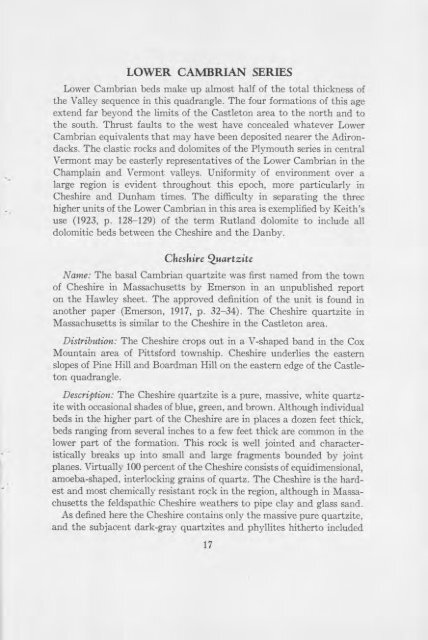STRATIGRAPHY AND STRUCTURE CASTLETON AREA VERMONT
STRATIGRAPHY AND STRUCTURE CASTLETON AREA VERMONT
STRATIGRAPHY AND STRUCTURE CASTLETON AREA VERMONT
You also want an ePaper? Increase the reach of your titles
YUMPU automatically turns print PDFs into web optimized ePapers that Google loves.
LOWER CAMBRIAN SERIES<br />
Lower Cambrian beds make up almost half of the total thickness of<br />
the Valley sequence in this quadrangle. The four formations of this age<br />
extend far beyond the limits of the Castleton area to the north and to<br />
the south. Thrust faults to the west have concealed whatever Lower<br />
Cambrian equivalents that may have been deposited nearer the Adirondacks.<br />
The clastic rocks and dolomites of the Plymouth series in central<br />
Vermont may be easterly representatives of the Lower Cambrian in the<br />
Champlain and Vermont valleys. Uniformity of environment over a<br />
large region is evident throughout this epoch, more particularly in<br />
Cheshire and Dunham times. The difficulty in separating the three<br />
higher units of the Lower Cambrian in this area is exemplified by Keith's<br />
use (1923, p. 128-129) of the term Rutland dolomite to include all<br />
dolomitic beds between the Cheshire and the Danby.<br />
Cheshire Quartzite<br />
Name: The basal Cambrian quartzite was first named from the town<br />
of Cheshire in Massachusetts by Emerson in an unpublished report<br />
on the Hawley sheet. The approved definition of the unit is found in<br />
another paper (Emerson, 1917, p. 32-34). The Cheshire quartzite in<br />
Massachusetts is similar to the Cheshire in the Castleton area.<br />
Distribution: The Cheshire crops out in a V-shaped band in the Cox<br />
Mountain area of Pittsford township. Cheshire underlies the eastern<br />
slopes of Pine Hill and Boardman Hill on the eastern edge of the Castleton<br />
quadrangle.<br />
Description: The Cheshire quartzite is a pure, massive, white quartzite<br />
with occasional shades of blue, green, and brown. Although individual<br />
beds in the higher part of the Cheshire are in places a dozen feet thick,<br />
beds ranging from several inches to a few feet thick are common in the<br />
lower part of the formation. This rock is well jointed and characteristically<br />
breaks up into small and large fragments bounded by joint<br />
planes. Virtually 100 percent of the Cheshire consists of equidimensional,<br />
amoeba-shaped, interlocking grains of quartz. The Cheshire is the hardest<br />
and most chemically resistant rock in the region, although in Massachusetts<br />
the feldspathic Cheshire weathers to pipe clay and glass sand.<br />
As defined here the Cheshire contains only the massive pure quartzite,<br />
and the subjacent dark-gray quartzites and phyllites hitherto included<br />
17













